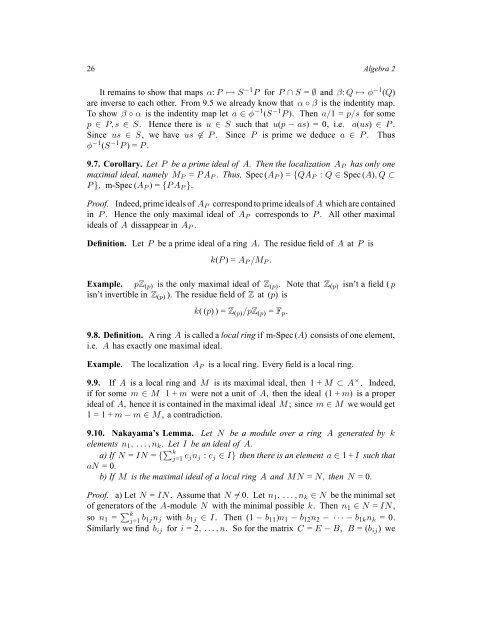Algebra (Unknown 27). - Index of
Algebra (Unknown 27). - Index of
Algebra (Unknown 27). - Index of
Create successful ePaper yourself
Turn your PDF publications into a flip-book with our unique Google optimized e-Paper software.
26 <strong>Algebra</strong> 2<br />
It remains to show that maps α: P ↦→ S −1 P for P ∩ S = ∅ and β: Q ↦→ φ −1 (Q)<br />
are inverse to each other. From 9.5 we already know that α ◦ β is the indentity map.<br />
To show β ◦ α is the indentity map let a ∈ φ −1 (S −1 P ). Then a/1 = p/s for some<br />
p ∈ P, s ∈ S. Hence there is u ∈ S such that u(p − as) = 0, i.e. a(us) ∈ P .<br />
Since us ∈ S, we have us ∉ P . Since P is prime we deduce a ∈ P . Thus<br />
φ −1 (S −1 P ) = P .<br />
9.7. Corollary. Let P be a prime ideal <strong>of</strong> A. Then the localization A P has only one<br />
maximal ideal, namely M P = P A P . Thus, Spec (A P ) = {QA P : Q ∈ Spec (A), Q ⊂<br />
P }, m-Spec (A P ) = {P A P }.<br />
Pro<strong>of</strong>. Indeed, prime ideals <strong>of</strong> A P correspond to prime ideals <strong>of</strong> A which are contained<br />
in P . Hence the only maximal ideal <strong>of</strong> A P corresponds to P . All other maximal<br />
ideals <strong>of</strong> A dissappear in A P .<br />
Definition. Let P be a prime ideal <strong>of</strong> a ring A. The residue field <strong>of</strong> A at P is<br />
k(P ) = A P /M P .<br />
Example. pZ (p) is the only maximal ideal <strong>of</strong> Z (p) . Note that Z (p) isn’t a field ( p<br />
isn’t invertible in Z (p) ). The residue field <strong>of</strong> Z at (p) is<br />
k( (p) ) = Z (p) /pZ (p) = F p .<br />
9.8. Definition. A ring A is called a local ring if m-Spec (A) consists <strong>of</strong> one element,<br />
i.e. A has exactly one maximal ideal.<br />
Example. The localization A P is a local ring. Every field is a local ring.<br />
9.9. If A is a local ring and M is its maximal ideal, then 1 + M ⊂ A × . Indeed,<br />
if for some m ∈ M 1 + m were not a unit <strong>of</strong> A, then the ideal (1 + m) is a proper<br />
ideal <strong>of</strong> A, hence it is contained in the maximal ideal M ; since m ∈ M we would get<br />
1 = 1 + m − m ∈ M , a contradiction.<br />
9.10. Nakayama’s Lemma. Let N be a module over a ring A generated by k<br />
elements n 1 , . . . , n k . Let I be an ideal <strong>of</strong> A.<br />
a) If N = IN = { ∑ k<br />
j=1 c jn j : c j ∈ I} then there is an element a ∈ 1 + I such that<br />
aN = 0.<br />
b) If M is the maximal ideal <strong>of</strong> a local ring A and MN = N , then N = 0.<br />
Pro<strong>of</strong>. a) Let N = IN . Assume that N ≠ 0. Let n 1 , . . . , n k ∈ N be the minimal set<br />
<strong>of</strong> generators <strong>of</strong> the A-module N with the minimal possible k. Then n 1 ∈ N = IN ,<br />
so n 1 = ∑ k<br />
j=1 b 1jn j with b 1j ∈ I. Then (1 − b 11 )n 1 − b 12 n 2 − · · · − b 1k n k = 0.<br />
Similarly we find b ij for i = 2, . . . , n. So for the matrix C = E − B, B = (b ij ) we

















